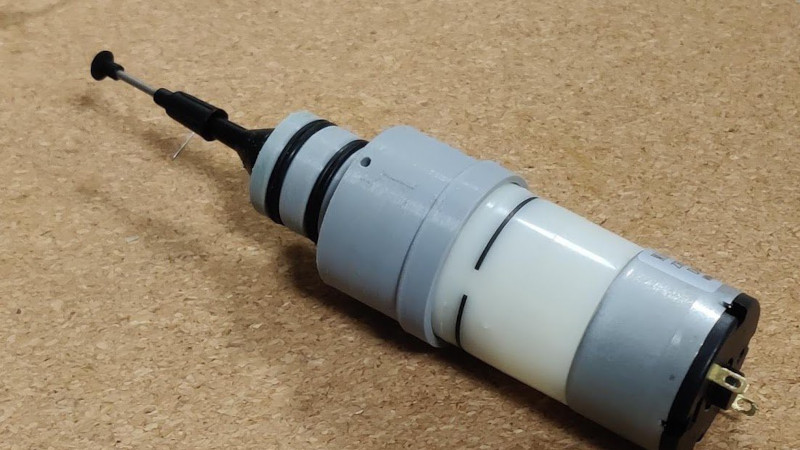When working with grain-of-dust surface-mount components, one of the tools which makes a huge difference is a vacuum pickup pen. Instead of trying to move the part with tweezers and succeeding only in flicking it into the middle distance, a tiny rubber suction cup with a vacuum feed allows you to pick it up and place it exactly where it is required. Unfortunately, good vacuum pickup tools come at a price, and very cheap ones aren’t worth the expenditure.
This is where [TDG (Béla)]’s SMD vacuum pickup tool comes in. The problem with the cheap tools is only that their manual vacuum is ineffectual, they come with the required array of probes with the suction cups. The solution is to take a small vacuum pump with a low voltage motor and attach it with a 3D printed adapter to the business end of a cheap vacuum tool and make a useful tool the result.
There’s a short video of the tool in action that we’ve placed below the break. It’s a bit noisy, but it’s obvious that it performs well. Control is via an air hole in the side of the 3D print, place a finger over it and the full suction is directed to the tip. The result is simpler and cheaper than previous contenders in the budget vacuum pickup stakes.
















I found the ultimate vacuum device after trying to build one from scratch!
I bought one of those silly blackhead removal devices from Ebay for $6.00 and free shipping. Not only has variable speeds but is rechargeable and comes with a nozzle selection. The only thing to do is improvise a vacuum release and that can at it’s simplest, a hole in the Tygon tubing added to the nozzle. I use it for a vacuum pull on a hypodermic syringe to move the head of my oscillating fan 😉
Now get ready for all the ads you’ll get across every website and device…
I wonder if the dollar store has something like that.
I was told that secondhand booger-vacuums for kids are cheap.
Your blackhead remover sounds much better!
I came across a cheap device that’s supposed to be for sucking the air out of tupperware containers. It provides a fairly good amount of suction pressure in a short amount of time, possibly too much for this application in it’s stock configuration. Essentially all you’d need to add is a needle. It comes with a very rudimentary pressure switch, but has the option to bypass it already built in.
Ohh. I have one of those already. Mine is meant for plastic bags, but same difference.
The air pump from a nebulizer makes an effective vacuum pump if the input and output connections are reversed. These can often be found at thrift stores for a few bucks. Add a dump valve (solenoid) and a footpedal and it’s easy to release components when they are in position. I use PWM to control the pump speed and therefore the vacuum, but I rarely need to change it.
I added a switch so the same foot pedal controls my solderpaste dispenser. Flip the switch to lay down the solder paste, change to the pickup nozzle in your hand and place the parts.
A very effective tool for a few bucks.
I recently found that RS components sell both a manual bladder-style pickup and a battery powered one, and the battery one is cheaper.
https://uk.rs-online.com/web/p/pick-up-tools/2222160
(£22 compared to £93 for the Weller-branded hacked-fountain-pen)
https://www.aliexpress.com/item/1005002612086101.html
22 quid for an “original RS” instead of 14 quid aliexpress OEM one is quite reasonable!
A slight side note, it’s well worth looking around the web for RS discount codes, 20% off is not uncommon. I had a code that remained active for about three years, I must have saved a small fortune during that time.
I once built such a tool with a surplus vacuum pump for car central locking. I had to reduce the voltage to 6V, then it worked very well. The pen was made from a syringe, a needle, some tubing and of course some hot glue.
I modified an aquarium pump very simply to be a vacuum pump. Then attached a hollow tube with a hole near the end and a large hypodermic needle filed blunt to the end. A tiny silicone vacuum cup goes on the end and it works great. Cover the small 3/32″ hole near the end with a finger and voila you have vacuum at the tip. Lift your index finger and the vacuum is broken. Look on YouTube for Aquarium pump to vacuum and you’ll find a bunch of instructions.
That is the coolest little pen! Super Useful.
I made myself one like this but with the pump in a base station with a tube running to the business end. I had discovered by chance at a pottery supply store that the screw-in metal tips used for applying fine glaze lines are available in 0.2mm and screw in nicely to replace the tip of a cheap ballpoint pen. Drilling a hole I can cover to pick up and release to drop and jamming the top of the pen in the vacuum hose gave me an easy and reliable way to move things ranging from 0102 passives to TQFP-144s and set them down with precision and ease.
Vacuum pickup tools like this are definitely ripe for DIY because the commercial ones are expensive due to low volume (rather than being expensive because they’re inherently difficult to make).